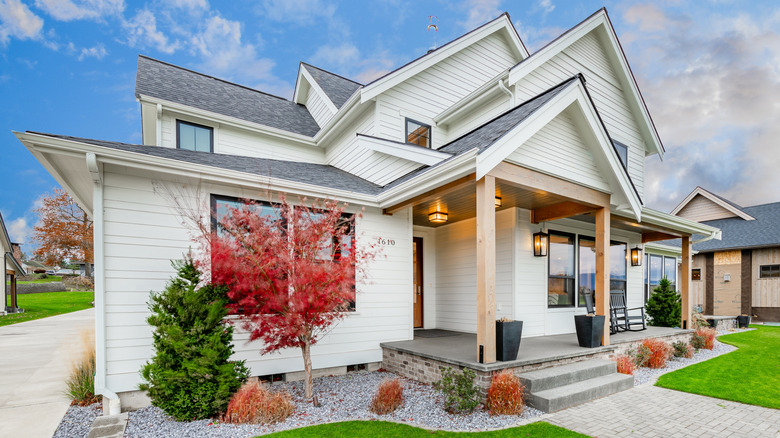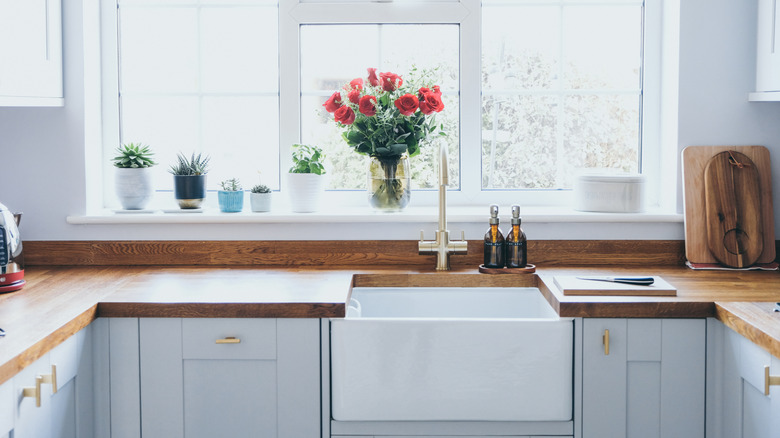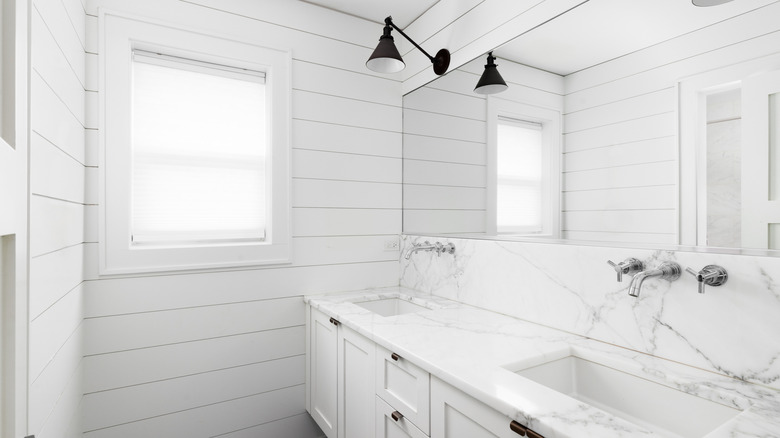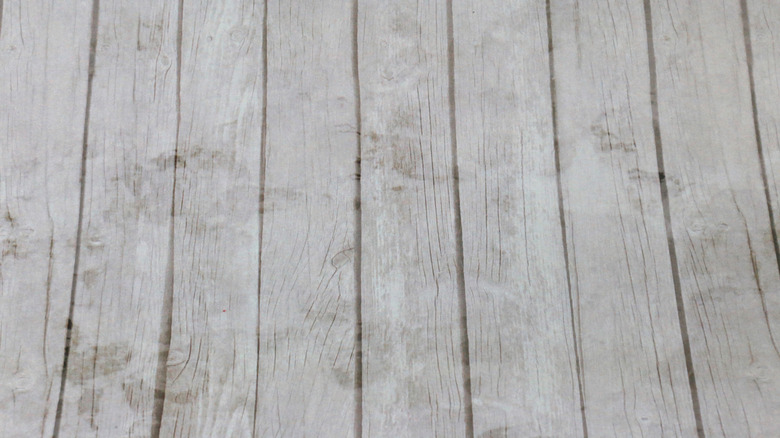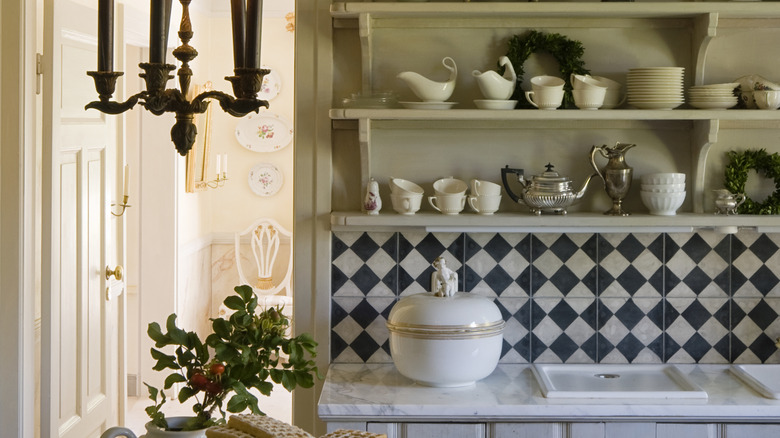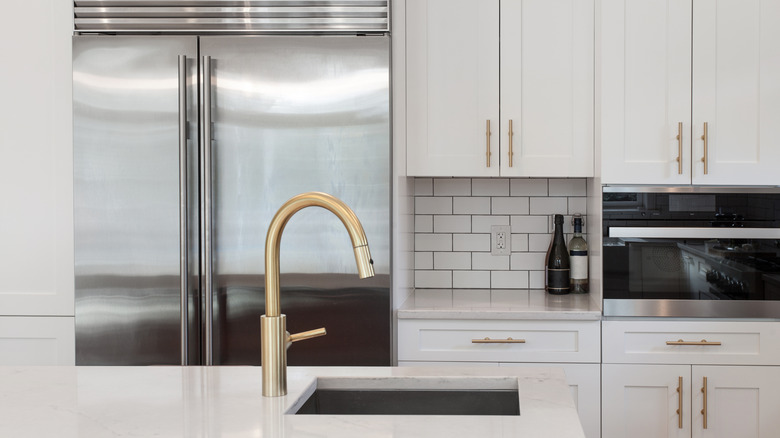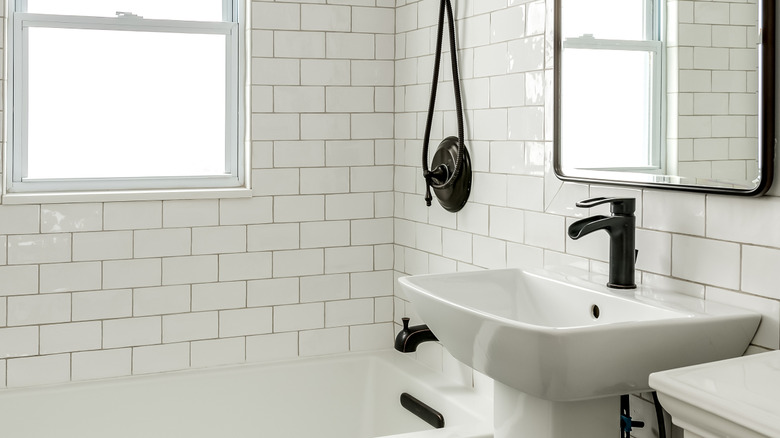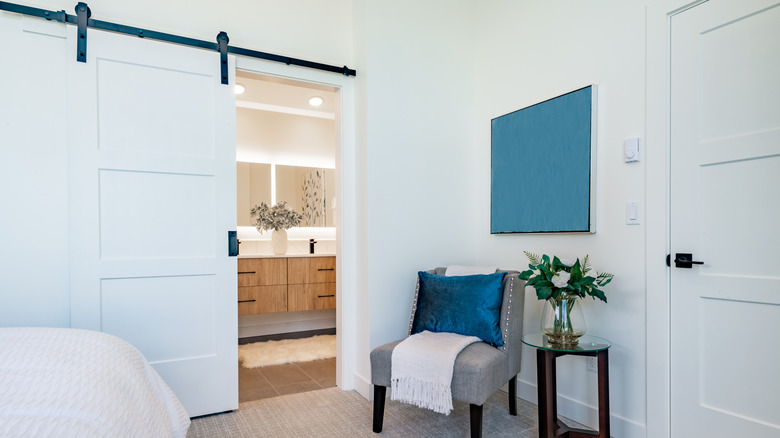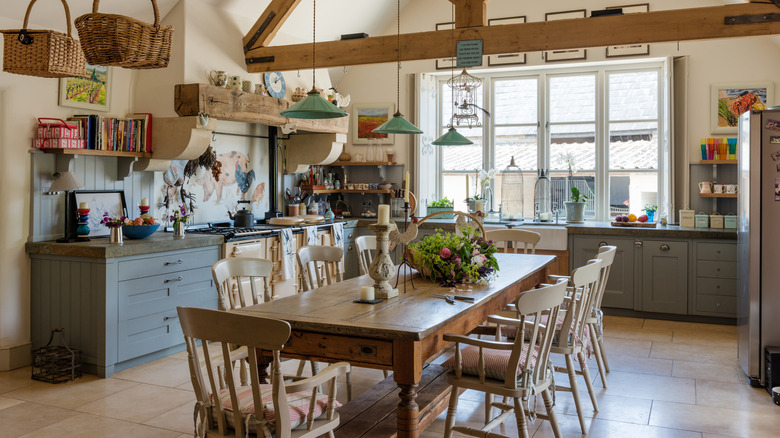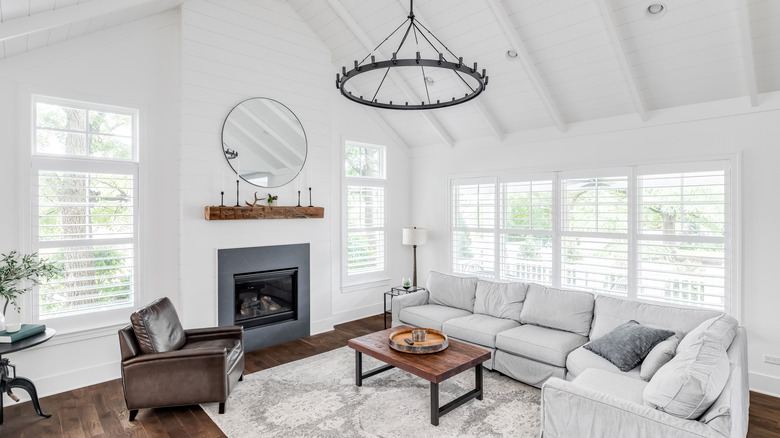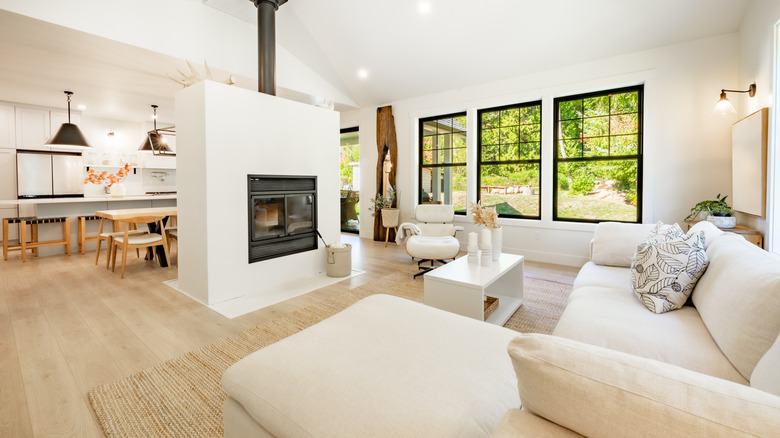Outdated Farmhouse Design Trends That Are Being Replaced In 2025
Farmhouses, both modern and traditional, remain as popular as ever. The design aesthetic feels warm and inviting — but only if it is done correctly. Like any decor movement, there are trends within the farmhouse space that seem to come and go. Some fade quickly, while others linger longer. In some cases, trends fall out of favor because they don't work or start to look awkward, while in others, they become so overused that their once-charming qualities feel tired and cliche.
In this House Digest exclusive, we spoke with experts in the design space about their thoughts and predictions for the new year. According to them, these are all the outdated modern farmhouse design trends that are being replaced in 2025. Whether you just love the farmhouse vibe, or are thinking or redesigning your own space — here is everything to avoid (and what to look out for instead).
All-white kitchens are soon to be a thing of the past
For a long time, plenty of designers have said that the all-white kitchen will never go out of style. However, if you live in a farmhouse, updated or not, it might be time to step away from the color (or lack thereof), as it's a bit overdone. "The all-white kitchen trend is cooling off," Alison Genet, founder and interior designer at European Frump, tells House Digest exclusively. "Homeowners are going for bolder colors and accents that add warmth and personality." It's true that if the white paint you choose has too cool of an undertone, the space can come off a bit sterile — more like a hospital ward than an inviting home.
Stark white is being swapped out for warmer neutrals, such as cream, a light beige mushroom, or a buttery white. However, there is a bigger movement towards incorporating earthier colors into the farmhouse kitchen, leaving the neutrals behind. "Neutrals are being replaced by bold colors and playful patterns, creating spaces that feel fun and yours," Genet says. Such colors include rich navies, earthy greens, playful terracottas, deep burgundies, and wooden accents. For instance, there has been a trend of adding wooden lowers but cream uppers, or accenting a white kitchen with wooden pantry cabinets and a wooden vent hood.
Part of the reason for this change has to do with a shift away from minimalism. "Minimalism is making way for maximalism, where layered textures, rich colors, and multiple patterns create spaces that feel full of life," Genet shares. In 2025, feel free to be brave and play around with design.
There actually is such a thing as shiplap overload
When you think farmhouse, you likely think shiplap. The material was popularized by Joanna Gaines on her hit show "Fixer Upper," but our experts think shiplap is now well past its prime. "Shiplap was a farmhouse favorite, but it's being phased out," Genet shares. "Designers are avoiding this overused element so a space doesn't feel too rustic or predictable." This is likely because it was everywhere in the 2010s, so even though it still looks great, it's too overdone. And Genet isn't the only one who thinks so. "Shiplap is still used, but it's a bit outdated. It seems to be so often used by everyone in the neighborhood that people are now choosing different wood and stacking it for the walls," Evelina Juzėnaitė, principal interior designer at Planner 5D Interior Design Council, tells House Digest exclusively.
Instead, "It's already being replaced by simple panels of different colors to create a more modern look and a natural aesthetic," Juzėnaitė continues. In the past, everyone chose white shiplap, but in 2025 and beyond, designers are more likely to choose stained wood or wood painted in bolder colors for a more exciting, unexpected vibe. "People are falling for bespoke and artisanal pieces that bring personality and authenticity to their homes, not the mass-produced farmhouse look," Genet adds.
Whitewashed floors are out of style
The farmhouse aesthetic has always featured a lot of white — crisp linens, white kitchens, and even white furniture and floors. Yet our designers agree that these days, enough is enough. "Whitewashing cabinets, wall paneling, and moldings have gone in and out of vogue over the decades, but one particular trend — whitewashing natural wood floors — has been absolutely emblematic of the farmhouse style for the last few years," Sarah Bilotta, House Digest's in-house architecture and design historian, curator, and editorial board member for the Journal of Design History, shares exclusively with us. "Unfortunately, the result is often a cold, greige floor that no longer fulfills the warm, eclectic look many homeowners are going for."
Greige is a bit of a modern invention, a combination of gray and beige that works in some instances, just not in this one. To avoid this fate if you want to go white, try to achieve it in other ways. Consider white tiling for the kitchen floor or sticking with cream colored accent rugs. As mentioned, all-white everything can tend to be a bit cold feeling, so leaving your wooden or LVP floors their natural, warm tone can actually add a touch of life to the room. They heat up the space just enough to avoid feeling sterile, but still don't look out of place.
Open shelves are too hard to take care of
Open shelves are a controversial design choice, one which HGTV stars often just can't seem to agree on. However, there is no disagreement between our experts: For farmhouse design, it's time to move on from them. "Open shelves, while stylish and practical, are falling out of favor because of the high maintenance," Genet says. "Dusting all those dishes isn't for everyone!" The kitchen is a messy place — that's no secret. Because of this, keeping things stored out in the open can be difficult. When dishes, pots, and pitchers are kept in a closed cabinet, they are less exposed to the dust and debris of the space. This means it's less likely you'll need to clean them off before using them, no matter how long it's been. However, if they are sitting out on an open shelf, it's not uncommon, as Genet points out, to dust them off before they are useful again.
Yet, keeping things physically clean isn't the only reason many designers are moving on from open shelves in farmhouse kitchens this year. It's important to keep things visually clean, too. "Open shelving tends to lead to accumulation of knick-knacks, which can unfortunately look cluttered," Bilotta adds. When everything is out in the open, it can easily overwhelm the eye. Instead, opt for charming closed cabinetry. This can mean retrofitting the open shelves with upper cabinets that match your current design, or, if the shelves are on a separate wall, replacing them with an antique hutch.
Shaker cabinets are being phased out
Shaker cabinets have been very popular in farmhouse design up until now. This is because they have a simple, yet stylish, facade sporting a flat center panel with straight edges. Designed for practicality, they are typically made of solid wood and come in neutral colors. Meant to be a timeless design, our experts are wary that this might not actually be the case. "[These are] also a bit outdated," Juzėnaitė shares. "Nowadays, they use facades of more minimalist design: with flat or fluted facades."
However, not everything about cabinet doors will change in 2025. The colors of these newly-designed pieces are likely to stay the same. "Of course, most often they are white or wood-colored as before," Juzėnaitė continues. If you are feeling over your shaker design, you don't need to rip out your cabinets completely. Instead, consider just updating the doors for a fresh new look. You can buy pre-fab doors anywhere from Lowe's to Home Depot to specialty sites like Cabinet Doors N' More. For instance, a Flat Panel Door from the latter costs $51 apiece.
Matte black fixtures have had their time
Bright, white cabinets with matte black pulls and sinks with matching black faucets have been a staple of the style, but many are now moving away from this. "They're starting to feel too predictable, especially when paired with the same white-and-wood palette we've seen everywhere," Angelique Kreller, interior designer at Yabby, tells House Digest in an exclusive interview. "While matte black can be timeless in moderation, so many people use it for every single faucet, light fixture, and cabinet handle — which can make the space feel super flat."
If you don't want your bathroom or kitchen to be boring, Kreller suggests flipping the script and reaching for metals instead — or even a mix of the two. "If you like this aesthetic, but want to change things up, brushed nickel, warm brass, or even copper are some alternatives that will add a bit more warmth to a farmhouse-inspired space," she says. For some, however, they simply have their hearts set on darker colors. This is fine, Kreller thinks, but with a few tweaks to still give life to your kitchen. "Use them sparingly and with some warmer tones to make the space feel layered," she says. You can achieve this easily with cabinets, as warm browns like "Newport cinnamon" tend to create a warm and comforting kitchen.
Barn doors are too much hassle
You can't have a modern farmhouse without a chic barn door, right? In the 2010s, every rustic living room, bathroom, and even garage seemed to have an interior barn door. Their hallmark was sliding across a track on the ceiling and almost "dangling" above the ground. Yet some of our experts see these doors as impractical — and predict you will see much less of them in 2025 and beyond. "As some farmhouse elements are already changing, barn doors are already going out of fashion as they are more difficult to combine," Juzėnaitė advises House Digest readers. Because they're so rustic, it's difficult to layer other elements in the space that aren't country- or homestead-inspired. And since farmhouse modern is evolving to be more maximalist and not so "on theme," this can be a problem.
Instead, designers are way more likely to include other options that still save space, but are a touch more functional. "Swinging doors or sliding doors will become more and more common," she continues, "whether they may be wooden, white, or glass with black frames." Sliding doors such as pocket doors are an elevated alternative for spaces that have little room for door clearance, such as a tight powder room. However, swinging doors such as glass paneled French doors for pantries or elegant double swing doors for interior rooms are becoming the new modern farmhouse staple.
Shabby furniture is no longer considered chic
One of the perks of farmhouse living is curating furniture that looks a bit older and lived-in. However, in 2025, our designers see the style moving away from this look. "I believe we'll see a shift from the overly distressed, 'shabby-chic' look. This includes the whitewashed and chipped paint furniture and the overuse of word art signs," Stefano Sette, brand ambassador at CHITA LIVING, tells HouseDigest in an exclusive. "While rustic elements will still have a place, homeowners will be looking for a more refined and sophisticated take on farmhouse style." So how will this manifest? With authenticity, Sette says, insisting that folks will instead gravitate towards "natural materials, warm colors, and handcrafted pieces with authentic characters." Rather than buying a white-washed wooden coffee table at HomeGoods, look for a heavy, gleaming coffee table with unique carvings. The idea is to find pieces that have character and that no one else might have, but also look like they're in mint condition, ensuring the space looks thoughtfully curated rather than pieced together through hand-me-downs.
And he isn't alone in this opinion, either. "Its time is already passing," Juzėnaitė adds, speaking of aged farmhouse furniture, whether artificially or on purpose. Instead, "neutral, new wooden furniture is more popular and will continue to grow" within the space. This gives people more freedom when designing their homes, as they don't feel trapped within a certain aesthetic when selecting pieces.
Staged-to-perfection homes aren't it
In the past, farmhouses tended to look like they all belonged in the pages of Southern Living magazine, or on the newest HGTV special. And while our experts agree that having a styled, well-put-together home is lovely, it's not the most important element of design in 2025. "Instead of the overly staged and 'perfect' farmhouse aesthetic, we'll see a move towards spaces that feel more lived-in and personal," Sette says. This is likely to manifest itself in homes that look more unique and personalized and less picture-perfect — which is what the aesthetic was kind of meant to be from the beginning.
"Expect to see less of the matchy-matchy sets and more of a curated, collected look," Sette continues. "This might include vintage and antique finds, unique textiles, and artwork that speaks to the homeowner's individual style." Rather than buying two matching white sofa chairs from Target and the wooden coffee table with black metal legs that everyone has, there is going to be a push to find unique finds that can't be duplicated. Having a mass-produced, "copy-pasted" room will no longer feel inspiring.
At the end of the day, Sette insists that the next generation of farmhouses will be "less about following a formula and more about creating a warm, inviting, and authentic home that reflects the people who live there." That is, instead of arbitrarily following an ultimate guide to farmhouse decor, folks might pick and choose what really speaks to them from the list, instead of following everything just because.
Soft colors are being replaced with bolder hues
Alongside the downfall of all-white kitchens and whitewashed floors, our experts think that neutral colors in general are on their way out of the farmhouse aesthetic. "More and more often, you can see that farmhouse style is no longer monochrome or the more white," Juzėnaitė warns our readers. "Instead, there are more colors like more black, a lot of brown, or even green. This year there will be more experiments with colors."
In the past, farmhouse Pinterest boards looked about as diverse as a dozen eggs. Sure, there were different tones here and there, but nothing too creative. Juzėnaitė looks forward to a fresh take on neutral in the new year. While you don't have to go too bold with deep navy blue cabinets and mismatched dining room chairs, consider incorporating colors in different ways. Pale pink drawer pulls against white cabinets still adds a playful touch, while a gingham tablecloth can stand in for a typical cream linen piece. The best part about using color in these secondary ways is that, unlike with big-ticket items like countertops and floors, it's easy to swap them out. In this way, you can be bolder when you take risks — as you're not stuck with it if it doesn't work out how you hoped.
